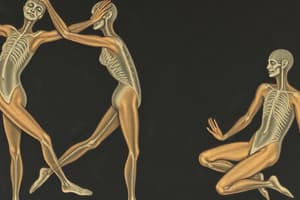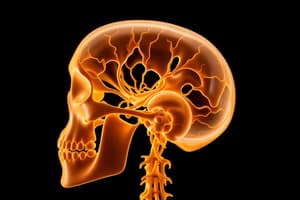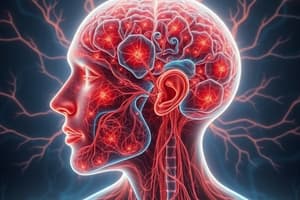Podcast
Questions and Answers
Which area of the motor cortex is primarily responsible for the planning of complex voluntary movements?
Which area of the motor cortex is primarily responsible for the planning of complex voluntary movements?
- Primary motor cortex
- Supplementary motor area
- Premotor area (correct)
- Basal ganglia
What is the role of the cerebellum in motor control?
What is the role of the cerebellum in motor control?
- Sequencing motor activities and making adjustments (correct)
- Planning all motor movements
- Generating reflexive responses
- Sending signals to the spinal cord only
Which statement about the primary motor cortex (PMC) is accurate?
Which statement about the primary motor cortex (PMC) is accurate?
- It is located in the postcentral gyrus.
- It stimulates movements bilaterally.
- It causes coordinated movements rather than specific muscle contractions.
- It is organized topographically according to body part function. (correct)
Which of the following best describes the types of motor output distinctions?
Which of the following best describes the types of motor output distinctions?
What characterizes the extrapyramidal system of motor pathways?
What characterizes the extrapyramidal system of motor pathways?
How does the motor cortex contribute to the adjustment of body posture?
How does the motor cortex contribute to the adjustment of body posture?
Which functional aspect is NOT served by the convergence of inputs onto motor neurons?
Which functional aspect is NOT served by the convergence of inputs onto motor neurons?
Which of the following statements is true about the representation in the primary motor cortex?
Which of the following statements is true about the representation in the primary motor cortex?
Which part of the nervous system is primarily responsible for controlling precise, skillful movements?
Which part of the nervous system is primarily responsible for controlling precise, skillful movements?
What is the primary effect of the extrapyramidal system on movements?
What is the primary effect of the extrapyramidal system on movements?
Which of the following structures primarily initiates the planning of movement?
Which of the following structures primarily initiates the planning of movement?
What type of paralysis is associated with a lower motor neuron lesion?
What type of paralysis is associated with a lower motor neuron lesion?
Which descending pathway is mainly responsible for setting postural background for movements?
Which descending pathway is mainly responsible for setting postural background for movements?
What is one characteristic feature of upper motor neuron lesions?
What is one characteristic feature of upper motor neuron lesions?
How do upper and lower motor neurons differ in terms of their location?
How do upper and lower motor neurons differ in terms of their location?
Which of the following is not a characteristic of an upper motor neuron lesion?
Which of the following is not a characteristic of an upper motor neuron lesion?
Flashcards
Primary Motor Cortex (PMC)
Primary Motor Cortex (PMC)
The primary motor cortex (PMC) is responsible for initiating and controlling voluntary movements.
What does the premotor area do?
What does the premotor area do?
The premotor area plans and sequences complex movements, working in conjunction with the PMC.
What is the function of the supplementary motor area?
What is the function of the supplementary motor area?
The supplementary motor area plays a key role in internally driven movements, coordinating movements between both sides of the body.
Motor Homunculus
Motor Homunculus
Signup and view all the flashcards
What is the Pyramidal System?
What is the Pyramidal System?
Signup and view all the flashcards
What is the Extrapyramidal System?
What is the Extrapyramidal System?
Signup and view all the flashcards
Role of the Cerebellum in Movement
Role of the Cerebellum in Movement
Signup and view all the flashcards
What does the Basal Ganglia do?
What does the Basal Ganglia do?
Signup and view all the flashcards
Pyramidal System
Pyramidal System
Signup and view all the flashcards
Extrapyramidal System
Extrapyramidal System
Signup and view all the flashcards
Pyramidal Decussation
Pyramidal Decussation
Signup and view all the flashcards
Upper Motor Neuron
Upper Motor Neuron
Signup and view all the flashcards
Lower Motor Neuron
Lower Motor Neuron
Signup and view all the flashcards
Lower Motor Neuron Lesion
Lower Motor Neuron Lesion
Signup and view all the flashcards
Upper Motor Neuron Lesion
Upper Motor Neuron Lesion
Signup and view all the flashcards
Babinski Sign
Babinski Sign
Signup and view all the flashcards
Study Notes
Motor System Objectives
- Students should understand how skilled movements are planned and executed.
- Students should be able to identify the motor cortex.
- Students must describe pyramidal and extrapyramidal motor tracts.
- Students need to discuss the cerebellum and basal ganglia functions.
Motor Cortex Subareas
- The motor cortex is divided into three subareas: primary motor cortex, premotor area, and supplementary motor area.
- The primary motor cortex controls specific muscle movements.
- The premotor area is involved in planning and coordinating movements.
- The supplementary motor area is responsible for complex and sequential movements.
Primary Motor Area (PMC)
- Located within the precentral gyrus.
- Topographically organized: the representation is proportional to the movement complexity of body parts. (e.g. hands, face and fingers are larger).
- Representation is upside-down.
- Innervates opposite side of the body, with some bilateral representation for the upper face.
- Stimulation of a specific part generates specific muscle contractions, without coordinated movement.
Control of Movement
- Inputs to motor neurons have three functions: initiating voluntary activity; adjusting posture for stable movement; and coordinating muscle action for smooth, precise movements.
- Posture adjustment occurs continually, even during movement, and is coordinated by the cerebellum.
Motor Output Types
- Two types of motor output exist: reflexive (involuntary) and voluntary.
- Reflex responses, e.g. chewing, swallowing, scratching, walking, can be adjusted voluntarily.
Planning of Movement
- Movement planning is a function of the cortex (association area), basal ganglia, and cerebellum (lateral portions).
- Basal ganglia and cerebellum relay information to the premotor and motor cortex.
- The cerebellum sequences motor activities and makes corrective adjustments during execution.
Motor Function
- Two parallel systems of descending pathways originate in the cerebral cortex (upper motor neurons): the pyramidal (corticobulbar and corticospinal) and extrapyramidal systems.
- Pyramidal tracts terminate in the brainstem (corticobulbar) or spinal cord (corticospinal) and control voluntary movements.
- Extrapyramidal tracts govern motor functions beyond the pyramidal system, for postural control, gross movements, and muscle tone.
Descending Spinal Pathways - Pyramidal System
- The pyramidal system mainly controls precise movements.
- At the medulla, 80% of corticospinal fibres cross over, innervating distal muscles.
- Remaining 20% innervate proximal muscles, directly synapsing with lower motor neurons.
Descending Spinal Pathways - Extrapyramidal System
- Includes rubrospinal, reticulospinal, tectospinal, and vestibulospinal tracts.
- Basal ganglia and thalamus influence these descending tracts.
- The extrapyramidal system establishes the postural background for skilled movements, controlling gross subconscious movements and muscle tone.
Summary of Control of Movement
- Movement Planning: basal ganglia, cerebellum, and cortical areas (association area).
- Movement Execution: pyramidal tract controls precise skilled movements, while the extrapyramidal tract provides the necessary background for skilled movements and subconscious gross motor actions (e.g. walking).
- Coordination: primarily performed by the cerebellum.
Upper and Lower Motor Neurons
- Upper Motor Neurons: cell bodies in the cortex of the brain; synapse with lower motor neurons.
- Lower Motor Neurons: cell bodies in the gray matter of the spinal cord and brainstem; synapse with muscles; also divided into alpha and gamma types.
Lesion Effects
- Lower Motor Neuron Lesion: lesion at the anterior horn cells (or below); results in flaccid paralysis, hypotonicity, hyporeflexia, areflexia, fasciculation, and muscle atrophy.
- Upper Motor Neuron Lesion: lesion above the anterior horn cells; results in spastic paralysis, hypertonicity, hyperreflexia, clonus, and a positive Babinski sign.
Studying That Suits You
Use AI to generate personalized quizzes and flashcards to suit your learning preferences.




